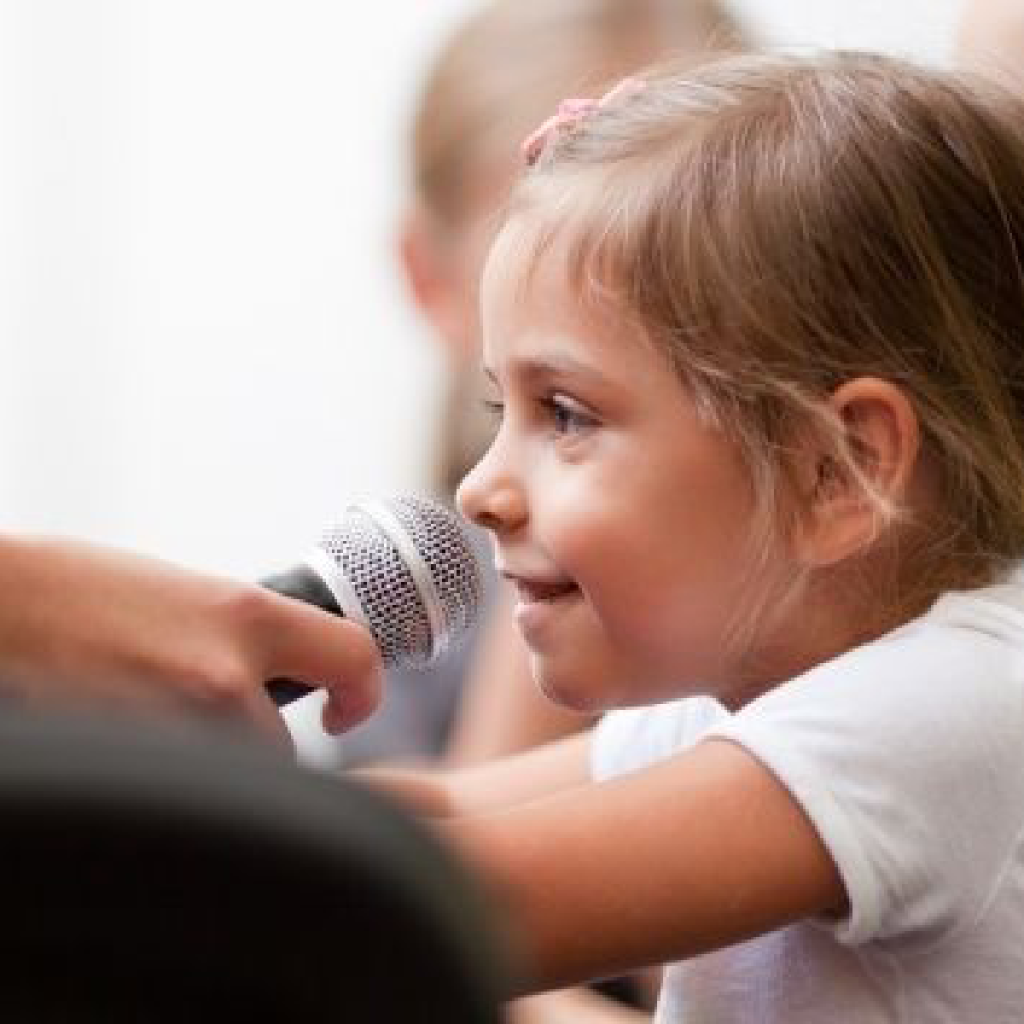Discover effective strategies and techniques for teaching public speaking to 2-3 year old children.
How to Teach Public Speaking to 2-3 Year Old Children
Do you believe in the power of public speaking? Even at a young age, children can benefit greatly from developing strong communication skills. In this article, we will explore the importance of teaching public speaking to 2-3 year olds and provide practical tips on how to do it effectively. So, get ready to embark on a playful journey of learning and growth!

Understanding the Importance of Public Speaking Skills in Early Childhood
Before we dive into the nitty-gritty of teaching public speaking to toddlers, let’s take a moment to appreciate the significance of this valuable skill. Communication plays a vital role in a child’s overall development. It helps them express their thoughts, feelings, and ideas with confidence.
By introducing public speaking at an early age, we can equip children with the essential tools they need to navigate through various social situations and successfully communicate their needs and desires.
The Role of Communication in Child Development
Effective communication skills facilitate cognitive, social, and emotional growth in young children. It helps them develop their vocabulary, language comprehension, and listening skills. Furthermore, it fosters their ability to empathize, negotiate, and resolve conflicts, which are essential life skills.
When children are able to communicate effectively, they are more likely to build positive relationships with their peers and adults. They can express their thoughts and feelings, leading to a greater sense of self-awareness and emotional intelligence. Additionally, strong communication skills lay the foundation for academic success, as it enables children to articulate their ideas and participate actively in classroom discussions.
Benefits of Public Speaking for Toddlers
Teaching toddlers public speaking may seem like an ambitious goal, but the benefits are worth it! Public speaking boosts their self-confidence, enhances their creativity, and refines their critical thinking abilities.
When toddlers engage in public speaking activities, they learn to organize their thoughts and present them in a clear and coherent manner. This process encourages them to think critically about the information they want to convey and how to effectively communicate it to their audience.
Moreover, engaging in public speaking activities helps toddlers overcome their shyness and stage fright, fostering a sense of empowerment that will serve them throughout their lives. As they become more comfortable speaking in front of others, they develop a strong sense of self-assurance and the ability to handle challenging situations with poise and confidence.
Furthermore, public speaking enhances toddlers’ creativity. It encourages them to think outside the box and find innovative ways to engage their audience. Through storytelling, presentations, or even show-and-tell activities, toddlers have the opportunity to express their unique ideas and perspectives, fostering their creative thinking skills.
Overall, teaching public speaking to toddlers not only equips them with essential communication skills but also nurtures their self-confidence, creativity, and critical thinking abilities. By providing them with a solid foundation in public speaking, we empower them to become effective communicators and confident individuals in all aspects of their lives.
Setting the Stage for Public Speaking
Now that we understand the significance of teaching public speaking to toddlers, let’s discover how to create an environment that encourages their growth and development.
Creating a Safe and Encouraging Environment
A safe and encouraging environment is crucial for toddlers to feel comfortable and willing to express themselves. Encourage open communication, active listening, and a non-judgmental attitude. Create an atmosphere where mistakes are seen as opportunities for growth and praise every effort, no matter how small.
When it comes to creating a safe and encouraging environment for toddlers, it’s important to consider the physical space as well. Ensure that the area is child-friendly, with soft and comfortable seating, colorful decorations, and age-appropriate toys and materials. This will help create a welcoming and inviting atmosphere that will make the toddlers feel at ease.
In addition to the physical environment, it’s also essential to establish clear and consistent rules and expectations. Set boundaries that promote respect and kindness, and teach the toddlers about taking turns and listening to others. By providing structure and guidance, you will help them develop important social and communication skills that are essential for public speaking.
Using Play and Fun Activities to Teach Speaking
Play is a child’s natural language! Incorporate imaginative play and interactive activities to make learning public speaking enjoyable. Encourage them to tell stories, engage in role-playing, and participate in show-and-tell sessions. By making it fun, you will ignite their curiosity and enthusiasm.
One effective way to incorporate play into public speaking lessons is through the use of puppets or stuffed animals. Toddlers can use these props to practice speaking in front of an audience, whether it’s a small group of their peers or their favorite stuffed animals. This playful approach not only helps them overcome stage fright but also allows them to explore different voices and characters, enhancing their storytelling abilities.
Another fun activity to teach speaking is through the use of picture cards. Create a set of cards with various images, such as animals, objects, or scenes, and ask the toddlers to describe what they see. This activity not only improves their vocabulary and descriptive skills but also encourages them to think on their feet and express their thoughts clearly.
Furthermore, incorporating music and movement into public speaking lessons can make the learning experience even more engaging. Encourage the toddlers to sing songs, recite rhymes, or perform simple dance routines while speaking. This multi-sensory approach helps them develop rhythm, intonation, and body language, all of which are important aspects of effective public speaking.
Developing Basic Public Speaking Skills
Now that we have set the stage for their public speaking journey, let’s explore how to develop their foundational skills.
Teaching Toddlers to Express Themselves
Start by nurturing their ability to express themselves clearly. Encourage them to share their thoughts and feelings, ask open-ended questions, and actively listen to their responses. By giving them the space to express themselves, you are validating their emotions and building their confidence.
One effective way to help toddlers express themselves is through creative activities. Engage them in art projects where they can use different mediums to express their thoughts and feelings. This not only enhances their communication skills but also allows them to explore their creativity.
Another important aspect of teaching toddlers to express themselves is by providing a supportive and non-judgmental environment. Create a safe space where they feel comfortable sharing their ideas without fear of criticism. This will encourage them to open up and develop their communication skills further.
Building Confidence in Young Speakers
Confidence is the key ingredient for effective public speaking. Help toddlers build their confidence by providing opportunities for them to speak in front of others. Encourage them to participate in simple group activities, such as show-and-tell or storytelling sessions. Celebrate their achievements and offer constructive feedback to help them grow.
In addition to group activities, it is essential to provide individual speaking opportunities for young speakers. This can be done through role-playing exercises or mock presentations. By simulating real-life speaking situations, toddlers can practice and gain confidence in their abilities.
Furthermore, it is crucial to teach toddlers the importance of body language and vocal projection. Encourage them to stand tall, make eye contact, and use expressive gestures while speaking. Practice voice modulation and emphasize the power of a clear and confident voice.
Another effective way to build confidence in young speakers is by exposing them to diverse speaking experiences. Take them to watch public speaking events, such as TED talks or school presentations. Exposing them to different speaking styles and topics will broaden their horizons and inspire them to develop their own unique voice.
Tools and Techniques for Teaching Public Speaking
When it comes to teaching public speaking, utilizing the right tools and techniques can make all the difference. Public speaking is a valuable skill that can benefit individuals in various aspects of their lives, from academic presentations to professional settings.
One effective tool for teaching public speaking is storytelling. Storytelling has been used for centuries as a means of communication and entertainment. By incorporating storytelling into public speaking lessons, educators can engage young minds and help them develop their speaking skills. Encouraging toddlers to tell stories, act out characters, and explore their imagination not only makes the learning process enjoyable but also enhances their vocabulary and boosts their self-expression skills.
Role-play is another powerful technique that can be used to teach public speaking. By engaging toddlers in role-play activities, educators can provide them with opportunities to practice speaking in different scenarios. Whether it’s pretending to be a news anchor delivering a report or acting out a scene from a favorite story, role-play allows children to step into different roles and practice their speaking skills in a fun and interactive way.
Utilizing Storytelling and Role-Play
Storytelling and role-play are not only effective tools for teaching public speaking but also have numerous benefits for children’s overall development. By encouraging toddlers to engage in storytelling and role-play, educators can help them develop their creativity, critical thinking, and problem-solving skills. These activities also promote language development and improve children’s ability to express themselves confidently and coherently.
Furthermore, storytelling and role-play provide a safe and supportive environment for children to explore their emotions and understand different perspectives. Through storytelling, children can learn about empathy and develop a deeper understanding of others’ experiences. Role-play, on the other hand, allows children to step into someone else’s shoes and gain insight into different roles and responsibilities.
Encouraging Participation in Group Discussions
In addition to storytelling and role-play, another important aspect of teaching public speaking is encouraging participation in group discussions. Group discussions provide an opportunity for children to express their opinions, share ideas, and learn from others. By promoting inclusive group discussions, educators can foster a collaborative learning environment where children can develop their communication and social skills.
When facilitating group discussions, it is essential to create a safe and respectful space where children feel comfortable expressing their thoughts. Educators can introduce age-appropriate topics that spark children’s interest and encourage them to engage in active listening and turn-taking. By actively involving children in group discussions, educators can help them develop their ability to articulate their ideas, listen to others’ perspectives, and engage in meaningful conversations.
Participating in group discussions not only enhances children’s public speaking skills but also promotes critical thinking, problem-solving, and teamwork. Through these discussions, children learn to respect and value different opinions, develop their ability to construct well-reasoned arguments, and collaborate effectively with their peers.
Overcoming Challenges in Teaching Public Speaking to Toddlers
Teaching public speaking to toddlers can present its fair share of challenges. Let’s explore some common obstacles and how to overcome them.

Dealing with Shyness and Anxiety
Shyness and anxiety are natural hurdles to overcome when teaching public speaking. Create a supportive and nurturing environment where toddlers feel safe to express themselves. Gradually introduce activities that gradually expose them to larger audiences. With time and constant encouragement, their confidence will blossom.
Addressing Speech and Language Delays
In some cases, toddlers may face speech and language delays, making public speaking more challenging. Seek professional guidance from speech therapists or language specialists who can formulate tailored exercises and techniques. By addressing these delays, you are providing toddlers with the necessary support to thrive in their public speaking journey.
Remember, teaching public speaking to toddlers is an exciting and rewarding endeavor. Embrace their playful curiosity, provide a nurturing environment, and watch them soar as confident young speakers. Together, let’s empower the next generation to communicate with clarity and charm!



